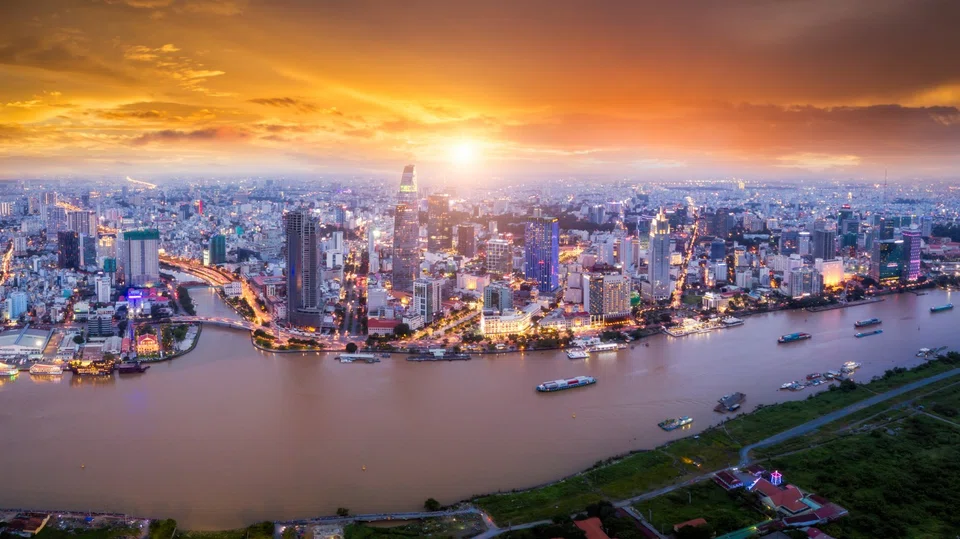Vietnam's cautionary tale on benefiting from the trade war and the BRI
Vietnam is a rising star amongst Southeast Asian economies. Its GDP totalled US$238.5 billion in 2018 and its economy grew more than 7%, the fastest it has grown since the 2008 global financial crisis. Many said Vietnam is benefiting from the China-US trade war and stands to gain from Chinese investments and the BRI. But what is the reality? Researcher Yu Hong was in Vietnam to find out.

Vietnam is China's largest neighbour in Southeast Asia and Chinese culture has a longstanding historical influence on the country. As an important part of China's Belt and Road Initiative (BRI), especially in the Maritime silk route, Vietnam is also becoming an increasingly important Southeast Asian trading partner to China. In fact, the country has displaced Malaysia as China's biggest trading partner in the region and it is also China's eighth-largest trading partner in the world. Official figures from the Vietnamese government indicate that trade between China and Vietnam grew more than 12% in 2018 to surpass US$100 billion.
Being part of the BRI will not only help Vietnam attract more Chinese investments for its infrastructure development but will also provide Vietnamese goods with a platform to enter the Chinese market more conveniently.
Vietnam has a seemingly insatiable appetite for domestic infrastructure investment. Since the country does not have the requisite funds and technical capabilities, it has to rely on foreign investments and infrastructure firms to rapidly develop its infrastructure so as to sustain economic growth. According to the Belt and Road Economics: Opportunities and Risks of Transport Corridors report published by the World Bank Group in 2019, transport projects under the BRI could increase trade volume, boost foreign investments and reduce poverty levels by lowering trading costs. If fully implemented, the BRI transport projects could increase global trade volume between 1.7 and 6.2%, with a 0.7 to 2.9% growth in global real income.

On the whole, Vietnam welcomes the BRI and it is also a founding member of the Asian Infrastructure Investment Bank, an initiative proposed by China. In November 2015, China's President Xi Jinping made a state visit to Vietnam. During his visit, both countries signed a joint statement to promote the integration of Vietnam's "Two Corridors and One Economic Circle" plan with the BRI, and also to enhance economic and trade cooperation between their local governments. It is clear to Vietnam that Chinese investments are needed to improve its infrastructure quickly, for industrialisation to take off in the country and to sustain economic growth. Being part of the BRI will not only help Vietnam attract more Chinese investments for its infrastructure development but will also provide Vietnamese goods with a platform to enter the Chinese market more conveniently.
However, there is also a longstanding dispute between the two over maritime rights and territorial claims in the South China Sea which has undermined mutual trust. Both were also previously involved in a border war and this explains Vietnam's wariness towards China.
Nonetheless, due to the fear of debt trap, Vietnam adopts a relatively cautious stance, as compared to other Southeast Asian countries like Laos and Cambodia, when it comes to seeking Chinese loans to develop its infrastructure. Even though Vietnam has signed a Memorandum of Understanding with China on the BRI, promoting the initiative has failed to gain significant traction in the country.
China and Vietnam are neighbours and share many similarities: they are both socialist countries led by communist political parties, and have similar political systems and ideologies. However, there is also a longstanding dispute between the two over maritime rights and territorial claims in the South China Sea which has undermined mutual trust. Both were also previously involved in a border war and this explains Vietnam's wariness towards China.

China's presence in the South China Sea and its sovereignty disputes with Vietnam in the same area are sensitive issues that can easily trigger nationalist sentiments in Vietnam. Based on the findings of a 2018 survey conducted by Singapore's ISEAS - Yusof Ishak Institute, more than 60% of Vietnamese respondents felt that China is a revisionist power that intends to bring Southeast Asia into its sphere of influence. In addition, nearly 60% of the Vietnamese respondents were of the view that the BRI will bring the countries of Southeast Asia closer into China's orbit.
In June 2018, the Vietnamese National Assembly tabled a draft bill to develop special economic zones in Van Don, Bac Van Phong and Phu Quoc. Even though the proposed law would help Vietnam attract foreign investments, and boost economic growth and industrial development, protests erupted in many Vietnamese cities after its introduction. Although this draft bill did not mention China at all, a sizeable portion of the Vietnamese population felt that passing the draft bill would make it easier for Chinese companies to seize control of Vietnamese land, thereby undermining Vietnam's territorial sovereignty and political independence. Due to the vehement demonstrations, the Vietnamese government was forced to delay a vote on the draft bill. It is no sign that this draft bill will be re-introduced to the Vietnamese National Assembly anytime soon. This incident is a clear reflection of the suspicion and dislike that the Vietnamese people harbour against China.
Vietnam hopes to maintain its friendly relations with the various big powers so that it has plenty of room for strategic manoeuvring in foreign relations and can maximise its national interests.
Through interactions and discussions with Vietnamese academics, this author sensed that they were of the view that the BRI goes beyond economic and trade cooperation, and has geostrategic implications. Proceeding with the BRI would strengthen China's sovereignty claims and bolster its presence in the South China Sea. Therein lie Vietnam's greatest concerns about the BRI and is something it is keen to avoid. At the same time, quite a few Vietnamese scholars felt that there is little transparency about how the BRI would be carried out, making the roles that participating countries have to play unclear.
Another outstanding issue between China and Vietnam is Vietnam's enormous trade deficit which reached US$20 billion in 2018. While Vietnam is buying plenty of mechanical machinery, info-communication products and electronics from China, it faces numerous non-tariff barriers, such as quality-control inspections, to selling its agricultural and aquatic products to China.

As competition between China and the United States intensifies, Vietnam, like other countries in the region, has adopted the strategy of remaining neutral and not openly taking sides. Vietnam hopes to maintain its friendly relations with the various big powers so that it has plenty of room for strategic manoeuvring in foreign relations and can maximise its national interests.
While Vietnam supports and participates in the BRI to attract Chinese investments, and accelerate industrial development and economic growth, the country is also of the view that it needs to gradually wean itself off its trade and economic reliance on China in the long term, so as to avoid being constrained by its northern neighbour both strategically and diplomatically.
Vietnam has also been trying to build up its trade and economic links with other countries and has adopted a market diversification strategy in an attempt to counter China's economic influence over it by being actively involved in regional multilateral organisations such as the Comprehensive and Progressive Agreement for Trans-Pacific Partnership (CPTPP). In November 2018, Vietnam became a signatory of the CPTPP. The Vietnamese government sees the signing of the CPTPP as a crucial strategic move to counter China's might, accelerate trading markets diversification, and reduce its over-reliance on the Chinese market.
From a long-term perspective, the CPTPP will aid Vietnam in developing an export-oriented economy and advance its industrial development. Assessments carried out by the Vietnamese government indicate that joining the CPTPP will help the country's GDP and exports grow by 1.32% and 4.04% respectively by the year 2035.
While textile and apparel production are two of Vietnam's biggest industries (in terms of export), more than 75% of the raw materials and semi-finished products in the two industries are imported from China.
After the CPTPP entered into force (in Vietnam) in January 2019, other CPTPP member countries pledged to waive tariffs on Vietnamese products, especially textiles, footwear, agricultural products and seafood. To keep its side of the bargain and fulfil CPTPP entry requirements, Vietnam has to substantially reform its domestic laws and regulations on external trade, customs, state-owned enterprises, competition rules, trade unions, intellectual property and domestic procurement. While such reforms will bring challenges and pain, they will make Vietnam more competitive in the long run.
Vietnamese scholars opine that in the short term, the CPTPP will have very limited impact in terms of changing Vietnam's foreign trade structure and boosting its economy. Conversely, Chinese economic factors have a greater influence on the development of the Vietnamese economy. Trade with China has always been an important part of Vietnam's external trade. China has been Vietnam's biggest trading partner for many years (accounting for nearly 20% of Vietnam's external trade volume) and is also its biggest source of imports. While textile and apparel production are two of Vietnam's biggest industries (in terms of export), more than 75% of the raw materials and semi-finished products in the two industries are imported from China.

Vietnam's GDP totalled US$238.5 billion in 2018 and its economy grew more than 7%, the fastest it has grown since the 2008 global financial crisis, making the country a star performer amongst Southeast Asian economies. The country is also one of the top destinations for foreign investments in Asia. Vietnam hopes to utilise its advantage of low production costs and follow in China's footsteps to become a manufacturing powerhouse. At the same time, the overall competitiveness of the Vietnamese economy is also improving. Based on The Global Competitiveness Report 2019 published by the World Economic Forum, Vietnam's position went up by 10 places (as compared to 2018) in the global competitiveness ranking, making it one of the most improved economies.
A number of Vietnamese scholars also pointed out that widespread media reports on Vietnam having the most to gain from the China-US trade war are exaggerated.
Amidst the rise in China-US trade tensions and the imposition of heavy tariffs on Chinese imports to the United States, a considerable number of Chinese companies, as well as American companies with factories in China, are thinking of relocating their production lines from China to other places with low manufacturing costs in order to avoid the tariffs. While Vietnam is one of the favoured locations, Vietnamese academics have their reservations about whether the country can seize the opportunity to attract foreign manufacturers to set up factories in Vietnam. Firstly, these academics feel that Vietnam face competition from countries such as Bangladesh, Indonesia and Cambodia which can also offer low manufacturing costs. Next, they are also aware that domestic inadequacies such as poor infrastructure, and a shortage of land and skilled labour mean that Vietnam would find it difficult to cater to the many production lines moving out of China.
A number of Vietnamese scholars also pointed out that widespread media reports on Vietnam having the most to gain from the China-US trade war are exaggerated. The trade war between the two largest economies in the world already has a negative impact on global economic growth, investments and trade. As Vietnam's economic development is reliant on external trade, it is impossible for the country to remain unscathed by the China-US trade war.



![[Photos] Fact versus fiction: The portrayal of WWII anti-Japanese martyrs in Taiwan](https://cassette.sphdigital.com.sg/image/thinkchina/3494f8bd481870f7c65b881fd21a3fd733f573f23232376e39c532a2c7593cbc)

